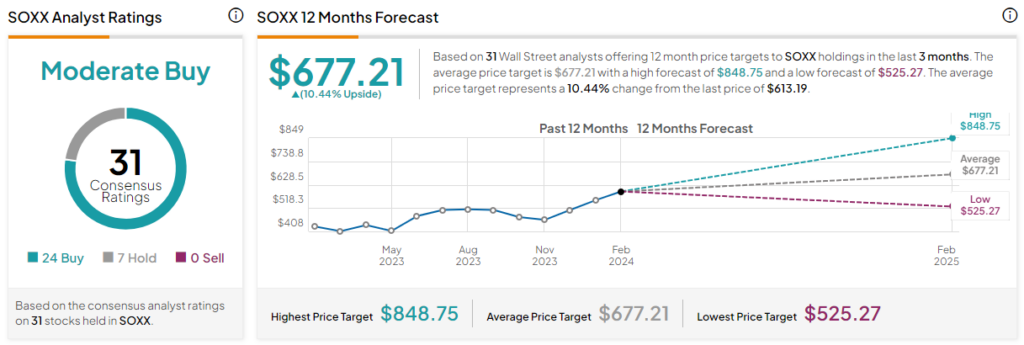The SPDR S&P Semiconductor ETF (NYSEARCA:XSD) is an interesting, diversified way to gain exposure to the semiconductor space. This ETF gives investors a different type of exposure to the semiconductor sector when compared to peers like the iShares Semiconductor ETF (NASDAQ:SOXX) and the VanEck Semiconductor ETF (NASDAQ:SMH).
TipRanks Cyber Monday Sale
- Claim 60% off TipRanks Premium for data-backed insights and research tools you need to invest with confidence.
- Subscribe to TipRanks' Smart Investor Picks and see our data in action through our high-performing model portfolio - now also 60% off
I’m bullish on this $1.5 billion ETF, as it has beaten the market over the long term and has a strong and diversified portfolio of top-rated semiconductor stocks. But there are also some significant considerations investors should weigh before choosing XSD over other semiconductor ETFs, which we’ll discuss in-depth in this article.
What Is the XSD ETF’s Strategy?
According to State Street Global Advisors, XSD seeks to give investors exposure to the semiconductor sector of the S&P Total Market Index (TMI) by investing in the S&P Semiconductor Select Industry Index.
The key difference between XSD and other popular semiconductor ETFs is that this is a “modified equal weighted index which provides the potential for unconcentrated industry exposure across large, mid and small cap stocks.” We’ll discuss what this looks like in practice further below.
XSD’s Portfolio
XSD holds 40 stocks, and because of its modified equal-weighted approach, its top 10 holdings comprise just 32.7% of assets. Below is an overview of XSD’s top 10 holdings from TipRanks’ holdings tool.

This approach starkly contrasts other prominent semiconductor ETFs like the SMH and SOXX. SMH holds just 25 stocks, and its top 10 holdings make up nearly three-quarters of its assets. SOXX holds 30 stocks, and its top 10 holdings comprise 60.1% of assets.
Because of this, XSD is a more diversified way to invest across stocks of all market caps within the semiconductor space and doesn’t leave investors with as much exposure to just a handful of names. For example, Nvidia (NASDAQ:NVDA) is SMH’s largest holding and accounts for a massive 24.8% of the fund’s assets. Nvidia is also XSD’s largest holding, but it accounts for a more manageable 3.9% of the fund.
Now, Nvidia is a great stock, and its surge over the past year has helped drive SMH’s stellar performance, but XSD gives investors a less concentrated portfolio where results won’t be as impacted by the performance of Nvidia and a handful of other names.
Overall, XSD owns a strong group of stocks. Eight of its top 10 holdings receive Smart Scores of 8 or above. The Smart Score is a proprietary quantitative stock scoring system created by TipRanks. It gives stocks a score from one to 10 based on eight market key factors. A Smart Score of 8 or higher is considered equivalent to an Outperform rating.
Notably, Advanced Micro Devices (NASDAQ:AMD), Broadcom (NASDAQ:AVGO), Marvell Technology (NASDAQ:MRVL), and Allegro Microsystems (NASDAQ:ALGM) all boast ‘Perfect 10’ Smart Scores.
XSD itself receives a Neutral-equivalent 7 out of 10 Smart Score.

The Pros and Cons of XSD’s Performance
There is a “glass-half-empty” and a “glass-half-full way” to view XSD’s performance, as we’ll discuss below.
As of January 31, XSD has returned 5.8% annually over the past three years, 24.5% annually over the past five years, and 22.0% annually over the past 10 years.
While XSD’s three-year results are underwhelming, its five- and 10-year returns are outstanding. In fact, XSD has outperformed both the S&P 500 (SPX) and the tech-heavy Nasdaq (NDX) over both of these time frames.
As of January 31, the Vanguard S&P 500 ETF (NYSEARCA:VOO) returned 14.2% over the past five years and 12.6% over the past decade. Meanwhile, the Invesco QQQ Trust (NASDAQ:QQQ) has returned 20.7% over the past five years and 18.1% over the past 10 years.
On the other hand, while this has been a great performance, XSD has lagged behind its semiconductor peers like SOXX and SMH.
SOXX has superior annualized returns of 16.0% over the past three years, 31.1% over the past five, and 24.5% over the past 10.
Meanwhile, SMH also outperformed XSD with annualized returns of 18.8% over the past three years, 32.1% over the past five years, and 26.1% over the past decade.
While XSD’s returns have beaten the broader market, it’s hard to get around the fact that it has trailed its peers like SMH and SOXX. The clear difference here is that because they are not equal-weighted, SMH and SOXX have benefited from their largest positions. Nvidia, in particular, has posted outsized gains over the past year plus.
With that said, it’s possible that if Nvidia reverts to the mean a bit or other stocks in the semiconductor pack catch up with Nvidia, XSD could outperform its rivals going forward based on this regression.
How Expensive Is XSD?
XSD’s expense ratio of 0.35% means that an investor in the fund will pay $35 in fees on a $10,000 investment annually. This is the same expense ratio that SMH and SOXX both charge, as these funds are all competitors.
Is XSD Stock a Buy, According to Analysts?
Turning to Wall Street, XSD earns a Strong Buy consensus rating based on 34 Buys, seven Holds, and zero Sell ratings assigned in the past three months. The average XSD stock price target of $259.71 implies 19.7% upside potential.

Notably, according to their average price targets, analysts seem to be ascribing more upside to XSD than to SMH and SOXX. While XSD’s target implies 19.7% upside, the average SMH stock price target implies upside of 11.4%.

Meanwhile, the average SOXX price target of $677.21 implies upside of 10.4%.

The higher potential upside for XSD (according to analysts) can be explained by the fact that XSD has more exposure to the semiconductor stocks that have underperformed the sector’s leaders, like Nvidia, but may have further upside ahead.
Taking It All In
On the plus side, XSD has soundly beaten the market over the long term. It has a strong and diversified portfolio of highly-rated stocks in a secular growth industry, and it gives investors diverse exposure to many different semiconductor stocks.
On the negative side, while its equal-weighted approach is prudent and gives investors diversification, it clearly has hindered the ETF in recent years as the semiconductor sector’s biggest winners, like Nvidia, have driven superior gains for ETFs like SMH and SOXX, which have significantly higher exposure to the company.
At some point in the future, XSD’s equal-weighted approach may lead it to outperform SMH and SOXX if outsized winners like Nvidia revert to the pack and other semiconductor names outperform, but it’s unclear if or when that will happen.
In sum, I’m bullish on XSD and believe it will continue to be a strong performer over the long term. However, whether an investor prefers XSD over bigger recent winners like SMH and SOXX comes down to whether they want a more conservative, equal-weighted approach to the space (if, for example, they believe that shares of some of the industry’s biggest winners like Nvidia will come back down to earth) or an approach that gives more exposure to the top performers.
















